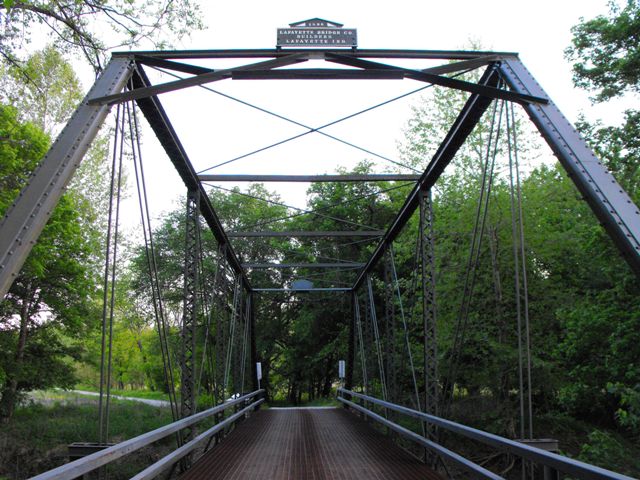We Recommend:
Bach Steel - Experts at historic truss bridge restoration.
BridgeHunter.com Phase 1 is released to the public! - Visit Now
Friendship Road Bridge
Monroe County Bridge 114

Primary Photographer(s): Nathan Holth and Rick McOmber
Bridge Documented: May 10, 2010
Rural: Monroe County, Indiana: United States
1898 By Builder/Contractor: Lafayette Bridge Company of Lafayette, Indiana
Not Available or Not Applicable
98.0 Feet (29.9 Meters)
100.0 Feet (30.5 Meters)
14 Feet (4.27 Meters)
1 Main Span(s)
5300110

View Information About HSR Ratings
Bridge Documentation
View Archived National Bridge Inventory Report - Has Additional Details and Evaluation
This bridge is an attractive example of a traditionally composed pin-connected Pratt truss bridge built by a prominent Indiana bridge builder.
This bridge was rehabilitated by J. A Barker Engineering and the bridge received an award for this rehabilitation. The rehabilitation was noteworthy because it was designed to make the most out of a very limited amount of funds available for repair. While a more extensive or more historically correct rehabilitation may have been possible, this solution kept this bridge standing and did so for a small amount of money. At the same time, the historic integrity of the bridge was not ignored either, given that J. A. Barker Engineering is a firm that specializes in historic bridge work. For example, the bridge had deterioration of the cover plate. A historically correct solution would be to carefully removed the cover plate, replicate a new plate and rivet it into place. A solution by a firm inexperienced with historic bridge rehabilitation in contrast might be to grind down the rivets, cover the entire original cover plate in a new plate, and weld everything together. The solution for this bridge however is a good balance between the two. A narrower strip of plate was welded onto the original cover plate. This allowed the cover plate to be strengthened, while at the same time not altering, obscuring or damaging the original rivets on the cover plate. Solutions like this represent the value of creativity in engineering, where preservation, safety, and fiscal responsibility can all combine to result in a solution where everyone involved benefits.
Information and Findings From DHPA Historic Bridge SurveyStatement of Significance These pinned and undecorated Pratt through trusses are conventionally designed. The original truss members still function. Architectural Description Seated upon concrete reinforced, cut stone abutments and wingwalls, this pin-connected Pratt through span extends 99' in six panels. A pair of laced channels of two different sizes provides each intermediate vertical, a pair of die-forged eyebars serves as each set of diagonals, and single, cylindrical rods with turnbuckles counter the diagonals in the two most central panels. The I floor beams are U-bolted to the lower pins. The bridge carries a 14' timber deck and 15'6" of vertical clearance. Bridge Considered Historic By Survey: Yes |
![]()
Photo Galleries and Videos: Friendship Road Bridge
Bridge Photo-Documentation
Original / Full Size PhotosA collection of overview and detail photos. This gallery offers photos in the highest available resolution and file size in a touch-friendly popup viewer.
Alternatively, Browse Without Using Viewer
![]()
Bridge Photo-Documentation
Mobile Optimized PhotosA collection of overview and detail photos. This gallery features data-friendly, fast-loading photos in a touch-friendly popup viewer.
Alternatively, Browse Without Using Viewer
![]()
Maps and Links: Friendship Road Bridge
Coordinates (Latitude, Longitude):
Search For Additional Bridge Listings:
Bridgehunter.com: View listed bridges within 0.5 miles (0.8 kilometers) of this bridge.
Bridgehunter.com: View listed bridges within 10 miles (16 kilometers) of this bridge.
Additional Maps:
Google Streetview (If Available)
GeoHack (Additional Links and Coordinates)
Apple Maps (Via DuckDuckGo Search)
Apple Maps (Apple devices only)
Android: Open Location In Your Map or GPS App
Flickr Gallery (Find Nearby Photos)
Wikimedia Commons (Find Nearby Photos)
Directions Via Sygic For Android
Directions Via Sygic For iOS and Android Dolphin Browser
USGS National Map (United States Only)
Historical USGS Topo Maps (United States Only)
Historic Aerials (United States Only)
CalTopo Maps (United States Only)

